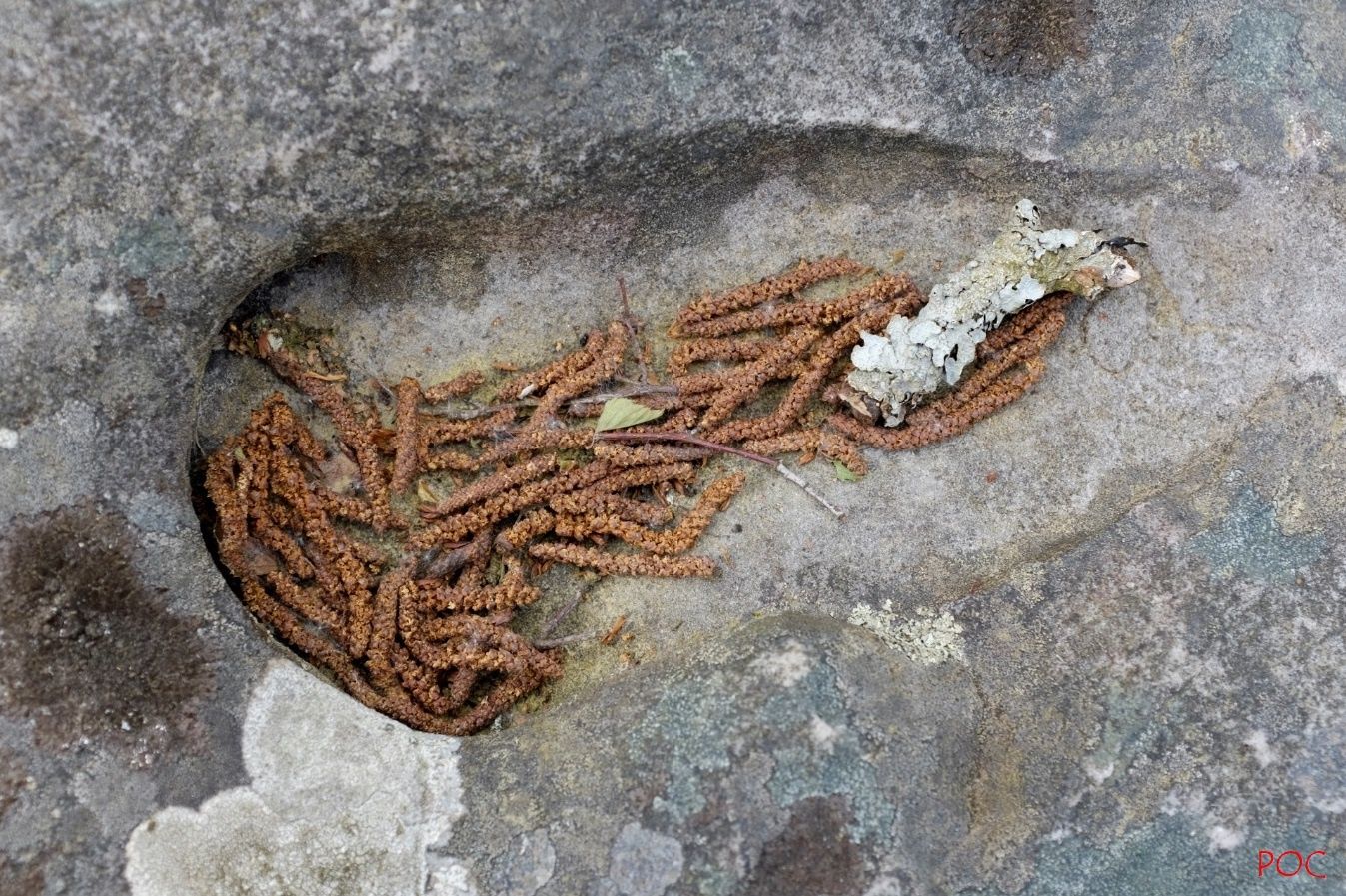Dans la forêt de Mai
Une Phalène (Cabera pusaria) s'est cachée à l'ombre, dans la caverne mésolithique, au coeur de la forêt.
Photographies: Pierre-Olivier Combelles (2018)
Appareil: Fujifilm X100T (focale fixe équiv. 35mm).
Il y a 32 ans: Tchernobyl, par Pierre Fetet (Fukuskima-blog)
Il y a tout juste 32 ans, se produisait l’accident nucléaire de Tchernobyl. A l’occasion de cet anniversaire, j‘édite une collection d’articles qu’on a pu lire au jour le jour dans la presse régionale de l’Est de la France. J’avais à l’époque conservé tous les articles paraissant sur la catastrophe dans deux journaux régionaux, La Liberté de l’Est, aujourd’hui disparu, et L’Est Républicain.
L’accident s’est produit le 26 avril 1986. Les informations n’ont commencé à émerger qu’à partir du 29 avril. Mais même si peu d’infos arrivaient, paradoxalement, les « experts européens » qui avaient analysé le nuage radioactif qui arrivait sur l’Europe avaient mieux communiqué publiquement la situation qu’en 2011 pour Fukushima car dès le 30 avril 1986, soit quatre jours après l’explosion, La Liberté de l’Est annonçait : « L’accident survenu à la centrale nucléaire soviétique de Tchernobyl près de Kiev (Ukraine), est bien dû à la fonte du cœur du réacteur (…) ». En 2011, il a fallu attendre 74 jours – oui vous avez bien lu – pour que Tepco avoue que trois cœurs avaient fondu, et c’est seulement après cette date que les « experts européens » ont reconnu la fusion des cœurs. Pourtant ceux-ci avaient accès aux informations via le réseau international d’analyse des composants nucléaires de l’atmosphère et donc connaissaient la gravité de l’accident. Cependant, ils n’ont rien dit.
Je vous laisse apprécier les différents titres qui se succédèrent dans les 3 premières semaines, du 26 avril au 17 mai 1986, en particulier ceux de L’Est Républicain du 3 mai : « France : aucune mesure sanitaire n’est nécessaire » et du 6 mai 1986 : « Tchernobyl, c’est fini ». La Liberté de l’Est, quant à elle, ne publia rien sur la catastrophe le 6 mai !
Aujourd’hui, un accident nucléaire serait-il plus difficile à cacher ? On le voit avec la pollution au ruthénium 106 de l’automne dernier, le village nucléaire mondial a toujours du mal à communiquer et on ne sait toujours pas officiellement, 6 mois plus tard, ce qui s’est passé !
Pierre Fetet
Source et article complet (illustré par ces coupures de journaux de l'époque): http://www.fukushima-blog.com/2018/04/il-y-a-32-ans-tchernobyl.html
Tolstoï, la désobéissance civile et la non-violence, par Marjolaine Jolicoeur
"Celui qui se voue corps et âme à ses semblables passe à leurs yeux pour un bon à rien, un égoïste, mais celui qui ne leur voue qu’une parcelle de lui-même est salué des titres de bienfaiteur et philanthrope."
H.D. Thoreau, La désobéissance civile.
(...)
Après avoir étudié le bouddhisme, l’hindouisme et discuté avec des anarchistes, le Sermon sur la montagne est pour Tolstoï une révélation. Selon lui les disciples de Jésus vivent en parfaite contradiction avec l’injonction « tu ne tueras point », autant quand ils vont à la guerre, à la chasse ou tuent des animaux pour leur chair. Toutes les violences sont interdépendantes et pour Tolstoï, « tant qu’il y aura des champs de bataille, il y aura des abattoirs ». Si Tolstoï se trouve des affinités avec le christianisme primitif, il reste cependant un chrétien anarchiste en marge de tous dogmes, rituels ou hiérarchies. Tout comme H.D.Thoreau dont il fera traduire en russe le texte sur la « Désobéissance civile », Tolstoï considère que la finalité des pouvoirs en place – l’état, l’armée, l’église – est de maintenir les humains dans la soumission, dans une forme d’hypnose dont il faut s’éveiller. Désobéir, ne plus coopérer, résister mais sans violence. Seule notre conscience individuelle est capable de nous guider pour mettre fin à la tyrannie de la loi du plus fort. « Notre vie doit être une friction contraire qui arrête la machine. », comme l’écrit H.D. Thoreau.
(...)
Source et article complet: https://liberationanimale.com/2010/07/19/vegetalisme-ethique-leon-tolstoi/
Fin de la temporada de caza en España: Matanza de perros (Cecilia Zamudio)
Por Cecilia Zamudio, Resumen Latinoamericano, 9 de febrero de 2018.-
Vert et bleu comme la forêt d'Avril
Vert et bleu comme la mer, comme le ciel entre les feuillages, comme les jacinthes et comme le lézard vert que j'ai rencontré aujourd'hui dans la forêt d'avril.
Pierre-Olivier Combelles
Kristina Olano
Pour une existence mythique (Mircea Eliade)
Il est indispensable de reconnaître qu'il n'existe plus de solution de continuité entre le monde «primitif » ou « arriéré » et l'Occident moderne. Il ne suffit plus, comme il suffisait il y a un demi-siècle, de découvrir et d'admirer l'art nègre ou océanien; il faut redécouvrir les sources spirituelles de ces arts en nous-mêmes, il faut prendre conscience de ce qui reste encore de «mythique » dans une existence moderne, et qui reste tel, justement parce que ce comportement est, lui aussi, consubstantiel à la condition humaine, en tant qu'il exprime l'angoisse devant le Temps.
Mircea Eliade, Les Mythes du monde moderne (1953)
Un renardeau blessé recueilli par le CEDAF/Association Faune Alfort
Nous avons rapporté le renardeau blessé dans un panier, recouvert par des rameaux de charme pour le protéger du soleil. Photo: Pierre-Olivier Combelles
Grâce au CEDAF le renardeau que nous avons trouvé blessé aujourd'hui dans la forêt de Rambouillet a peut-être une chance de survivre! Trois personnes nous ont téléphoné et c'est finalement un bénévole de Pontchartrain qui l'a emmené, une demi-heure après notre échange de courriels avec le CEDAF !
C'est mon fils aîné qui l'a découvert vers midi, à quelques mètres du chemin, en faisant une randonnée à pied dans le bois des Vindrins, près de St-Benoit, dans la forêt de Rambouillet. De retour à la maison, à Auffargis, il m'informe et je décide d'aller vite le chercher à vélo. Nous le retrouvons facilement, il n'a pas bougé. C'est un renardeau âgé d'un mois environ. Il est blotti au pied d'un arbre. Il a une grande lacération à l'épaule et ne peut pas se servir de sa patte gauche. Nous le faisons entrer dans le panier, que nous recouvrons avec des feuillages et nous repartons sur nos vélos. A la maison 1/2 h plus tard, nous le mettons à l'ombre, nous chassons les mouches qui ont déjà commencé à pondre dans son pelage. J'ai mis de l'argile verte sur sa plaie. Nous essayons de contacter des vétérinaires, mais pas facile un dimanche après-midi! Finalement, grâce à internet, nous tombons sur le CEDAF, j'envoie un courriel avec nos coordonnées, on me répond tout de suite, on échange, et une heure après, ne pouvant pas me déplacer moi-même à Maisons-Alfort, ce sont deux bénévoles de Pontchartrain contactés par facebook qui viennent le chercher et l'emmènent.
BRAVO ET MERCI POUR VOTRE GENTILLESSE, VOTRE EFFICACITE ET VOTRE RAPIDITE.
Que s'est-il passé avec ce renardeau, nous ne savons pas: un chien, un sanglier (possible: ses défenses tranchantes comme des rasoirs peuvent lacérer ainsi), un chasseur? Malheureusement, ici en forêt de Rambouillet, beaucoup d'animaux se font aussi écraser par les voitures (écureuils, fouines, martres, chevreuils, rapaces nocturnes, sans parler des crapauds et salamandres). Nous espérons que notre renardeau pourra être sauvé. Ma fille aînée voulait déjà l'adopter !
Dimanche soir, il a été vu par le vétérinaire du CEDAF, sa blessure a été nettoyée, il a été réhydraté par des injections et lundi matin il devrait être recousu.
Pierre-Olivier Combelles
Fondé à l'Ecole Vétérinaire de Maisons-Alfort, le CEDAF (Association Faune Alfort) recueille les animaux sauvages blessés: oiseaux, petits mammifères. Un réseau de bénévoles coordonne le transport des animaux, via les réseaux sociaux (et SMS je suppose). Contactez-les, aidez-les par vos dons ou par le bénévolat !
CEDAF (Association Faune Alfort) : https://www.faune-alfort.org/
Sur le même sujet et sur le même blog:
http://pocombelles.over-blog.com/2014/06/une-belle-martre-est-morte.html
Biodiversity: The ravages of guns, nets and bulldozers. By Sean L. Maxwell, Richard A. Fuller, Thomas M. Brooks & James E. M. Watson (Nature, 10 August 2016)
There is a growing tendency for media reports about threats to biodiversity to focus on climate change.
Here we report an analysis of threat information gathered for more than 8,000 species. These data revealed a contrasting picture. We found that by far the biggest drivers of biodiversity decline are overexploitation (the harvesting of species from the wild at rates that cannot be compensated for by reproduction or regrowth) and agriculture (the production of food, fodder, fibre and fuel crops; livestock farming; aquaculture; and the cultivation of trees).
Early next month, representatives from government, industry and non-governmental organizations will define future directions for conservation at the World Conservation Congress of the International Union for Conservation of Nature (IUCN). High on the agenda for political leaders, non-governmental organizations, conservationists and many others will be taking steps to turn the 2015 Paris climate agreement into action. It is also crucial that the World Conservation Congress delegates — and society in general — ensure that efforts to address climate change do not overshadow more immediate priorities for the survival of the world's flora and fauna.
(...)
What next?
Of all the plant, amphibian, reptile, bird and mammal species that have gone extinct since AD 1500, 75% were harmed by overexploitation or agricultural activity or both (often in combination with the introduction of invasive alien species7). Climate change will become an increasingly dominant problem in the biodiversity crisis3. But human development and population growth mean that the impacts of overexploitation and agricultural expansion will also increase.
The aim of the World Conservation Congress is to translate sustainable development and carbon neutrality agreements into action. We urge delegates to focus on proposing and funding actions that prioritize the biggest current threats to biodiversity.
Thankfully, there are effective tools and approaches to alleviate harm caused by overexploitation and agricultural activities8. These include the development and governance of sustainable harvest regimes; the enforcement of hunting regulations and no-take marine protected areas; the maintenance of international policy mechanisms; such as the Convention on International Trade in Endangered Species; and public education (for instance, on where ivory comes from) to reduce demand. Also powerful are the establishment of protected areas to safeguard key biodiversity areas9; the management of agricultural systems in ways that allow threatened species to persist within them; the regulation of pesticide and fertilizer use; the certification of agricultural sustainability; and the reduction of food waste, for example, using urban food-transfer programmes.
Crucially, ensuring that overexploitation and agricultural activities today do not compromise ecosystems tomorrow will help to ameliorate the challenges presented by impending climate change. Healthy ecosystems are better repositories for carbon. They are also more likely to provide the physical connectivity and genetic diversity needed to enable species to adapt to the large shifts in climate expected later this century10.
Conservationists, weary of tackling herculean, long-standing problems, could be forgiven for being drawn to newer ones. Nonetheless, we appeal to all concerned with the sustainability of life on Earth to take stock of the current balance of threats — and refocus their efforts on the enemies of old.
- Nature 536,143–145 () doi:10.1038/536143a
- Source: https://www.nature.com/news/biodiversity-the-ravages-of-guns-nets-and-bulldozers-1.20381

/image%2F0662944%2F20170313%2Fob_3490fc_poc-grands-reportages-nov-99.jpg)






























